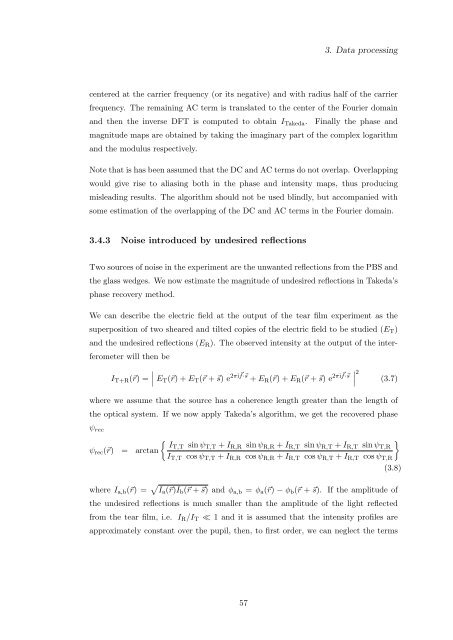Alfredo Dubra's PhD thesis - Imperial College London
Alfredo Dubra's PhD thesis - Imperial College London
Alfredo Dubra's PhD thesis - Imperial College London
Create successful ePaper yourself
Turn your PDF publications into a flip-book with our unique Google optimized e-Paper software.
3. Data processing<br />
centered at the carrier frequency (or its negative) and with radius half of the carrier<br />
frequency. The remaining AC term is translated to the center of the Fourier domain<br />
and then the inverse DFT is computed to obtain I Takeda .<br />
Finally the phase and<br />
magnitude maps are obtained by taking the imaginary part of the complex logarithm<br />
and the modulus respectively.<br />
Note that is has been assumed that the DC and AC terms do not overlap. Overlapping<br />
would give rise to aliasing both in the phase and intensity maps, thus producing<br />
misleading results. The algorithm should not be used blindly, but accompanied with<br />
some estimation of the overlapping of the DC and AC terms in the Fourier domain.<br />
3.4.3 Noise introduced by undesired reflections<br />
Two sources of noise in the experiment are the unwanted reflections from the PBS and<br />
the glass wedges. We now estimate the magnitude of undesired reflections in Takeda’s<br />
phase recovery method.<br />
We can describe the electric field at the output of the tear film experiment as the<br />
superposition of two sheared and tilted copies of the electric field to be studied (E T )<br />
and the undesired reflections (E R ). The observed intensity at the output of the interferometer<br />
will then be<br />
I T+R (⃗r) =<br />
∣ E T (⃗r) + E T (⃗r + ⃗s) e 2πi ⃗ f·⃗s + E R (⃗r) + E R (⃗r + ⃗s) e 2πi ⃗ f·⃗s<br />
∣ 2 (3.7)<br />
where we assume that the source has a coherence length greater than the length of<br />
the optical system. If we now apply Takeda’s algorithm, we get the recovered phase<br />
ψ rec<br />
ψ rec (⃗r) = arctan<br />
{ }<br />
IT,T sin ψ T,T + I R,R sin ψ R,R + I R,T sin ψ R,T + I R,T sin ψ T,R<br />
I T,T cos ψ T,T + I R,R cos ψ R,R + I R,T cos ψ R,T + I R,T cos ψ T,R<br />
(3.8)<br />
where I a,b (⃗r) = √ I a (⃗r)I b (⃗r + ⃗s) and φ a,b = φ a (⃗r) − φ b (⃗r + ⃗s). If the amplitude of<br />
the undesired reflections is much smaller than the amplitude of the light reflected<br />
from the tear film, i.e. I R /I T ≪ 1 and it is assumed that the intensity profiles are<br />
approximately constant over the pupil, then, to first order, we can neglect the terms<br />
57

















